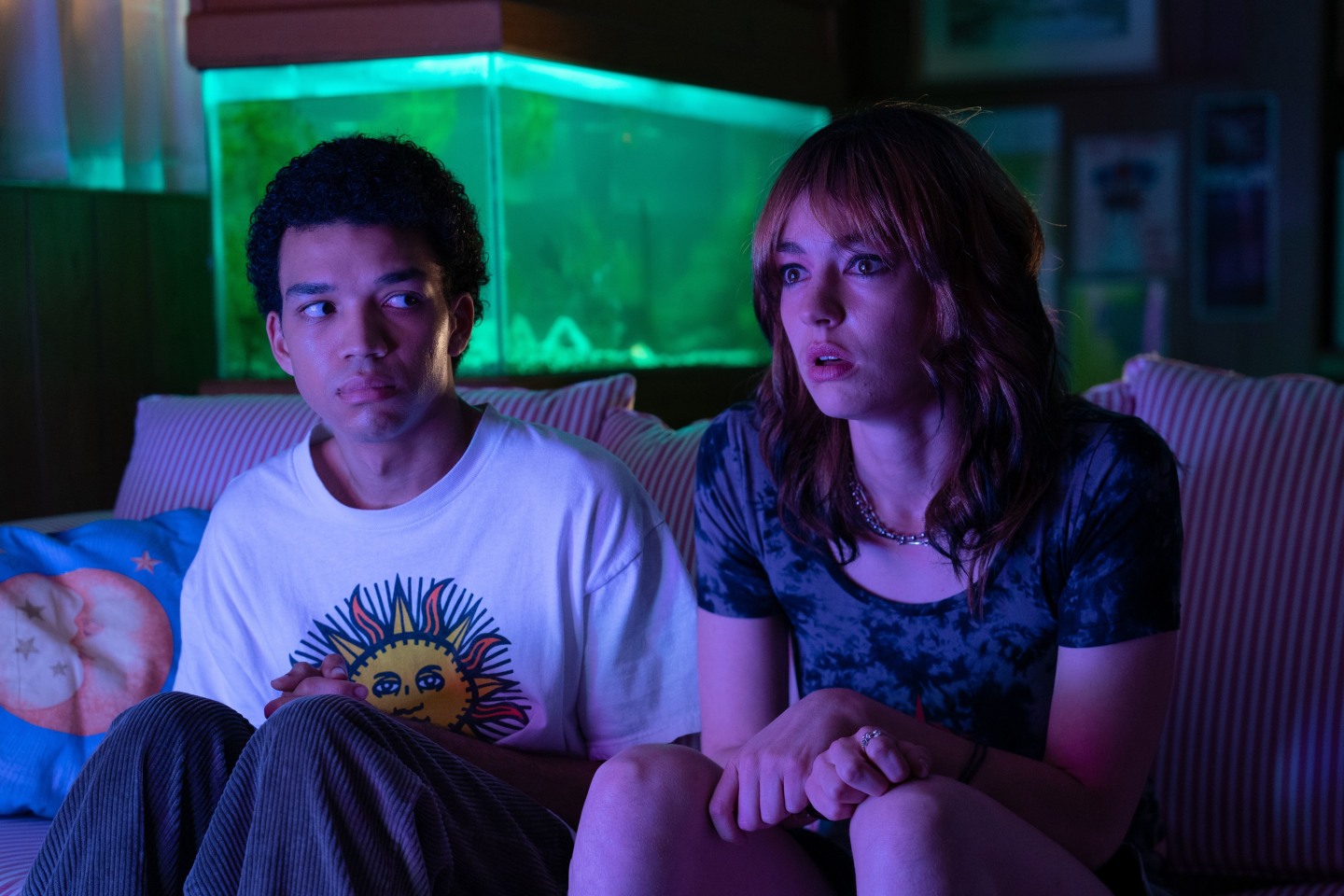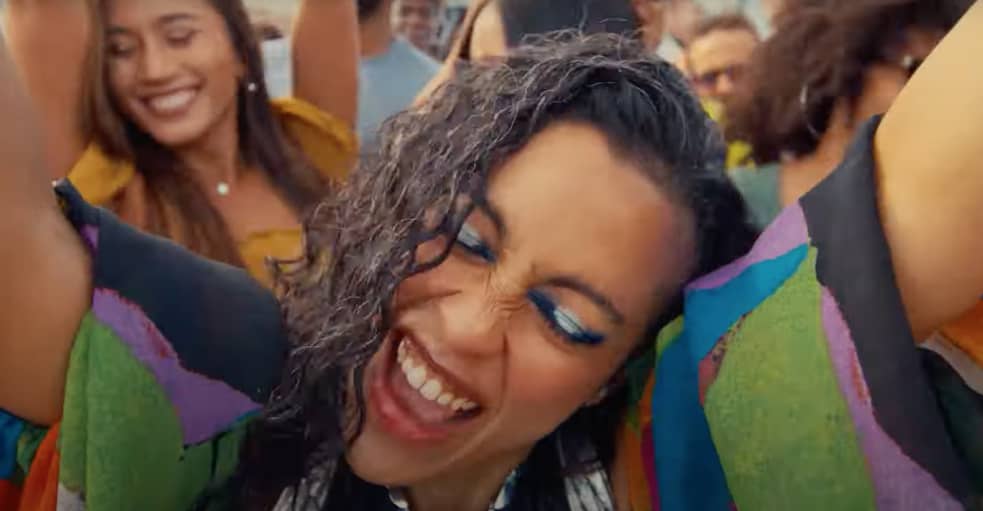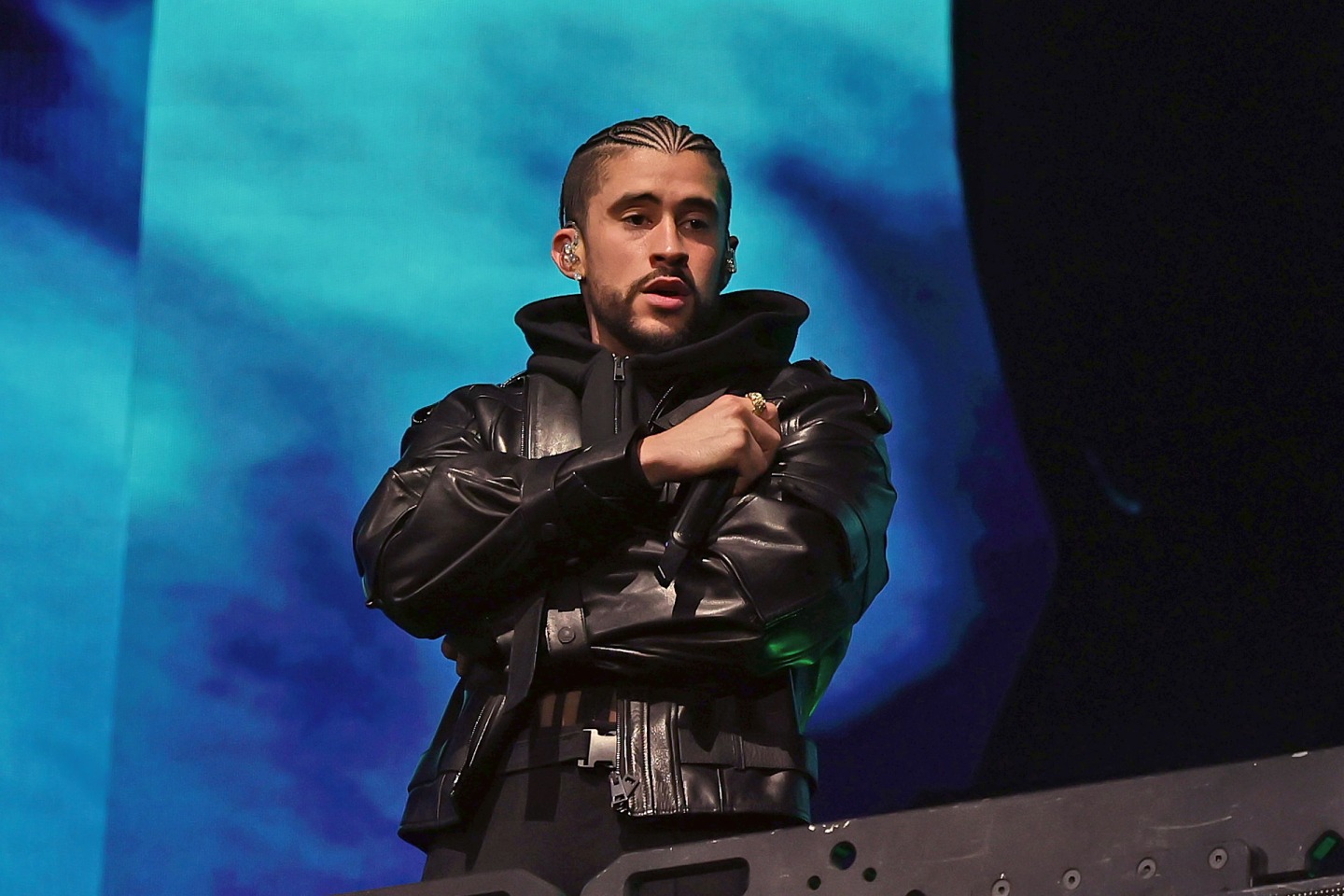I Saw The TV Glow”>
I Saw The TV Glow
A24
In Jane Schoenbrun’s films, ecstasy and annihilation coexist on the other side of a screen. Their 2021 debut We’re All Going To The World’s Fair took the chokehold of internet addiction and turned it into a horror movie; their new film I Saw The TV Glow returns to the genre and expands on the contemporary themes. Set in an uneventful town in the ‘90s, the A24 release follows disaffected teenagers Owen (Justice Smith) and Maddy (Brigette Lundy-Paine) who find their mundane realities skewed by a supernatural sci-fi TV series called The Pink Opaque. This show-within-a-movie is a clear homage to dark fantasy series like Buffy The Vampire Slayer and Are You Afraid of the Dark?, shows that drew teens in with their mix of campy thrills and broody angst.
Owen and Maddy’s The Pink Opaque fandom soon grows into a fantastical obsession and a vehicle for disassociation. Both make reference to unsettled home lives and it’s easy to see why the smooth edges of the fictional universe are more appealing than what lies behind their front doors. What is a TV if not a device to illuminate the darkest corner of a home?
The film has an unmistakeable love for music, from the small details (riot grrl posters on Maddy’s wall, a cameo from Lindsey “Snail Mail” Jordan, and a small role for Limp Bizkit frontman Fred Durst) to the music. The fantastical and unsettling vibe of the movie is carried perfectly across the accompanying album, which features carefully selected contributions from Caroline Polachek, yeule, and Bartees Strange. (For the score, Schoenbrun reunited with World’s Fair collaborator Alex G).
Speaking about the album, Schoenbrun tells The FADER that they asked the artists involved to write the song they would play if they were booked to play The Bronze, the fictional night club from Buffy the Vampire Slayer. “I definitely wanted artists who identified as queer and I wanted to make something people can live in,” they add. “It wasn’t a strict rule, but I knew that my natural inner world is very sad-girl queer, nocturnal, a little bit dance-y, a little bit dark energy. So I think it was just an intuitive process. You shouldn’t be too didactic because a good mixtape has to be consistently surprising and filled with secrets.”
I Saw The TV Glow’s soundtrack is out on May 10. Read on for a track-by-track guide to the album from Schoenbrun plus contributors Florist, L’Rain, and Sloppy Jane’s Haley Dahl.
yeule: “Anthems for a Seventeen Year-Old Girl”
Jane Shoenbrun: I think the movie is trying to do something anthemic. I loved “Anthems For A Seventeen Year-Old Girl” when I was a 17-year-old something, and I found so much comfort in that song, as I did in a lot of that kind of emotional indie rock that got me through my teenage years. There was something so mysterious and strange about that song. And something so queer about it, too. Even if I couldn’t find the words for it at that time, the way that it’s not only this song about not feeling comfortable in traditional mainstream femininity, but also just in the texture of the song, the way it’s produced, the way the vocals are doing this pitch modulation thing years before that would catch on in a wider way.
I always knew that it should be part of this movie. I took a lot of inspiration from the Donnie Darko soundtrack, and in the same way that movie is updating “Mad World” or Echo & the Bunnymen or whatever, this movie I really wanted to bring back some of those alt anthems that got me through my teens. So it made sense, and then I met yeule who I’m just such a huge fan of, I think their album from last year is one of my favorite albums of the decade, and I think at first we were talking about an original song, and then we started talking about covers. I was like, “Wait a second, you are the perfect person to cover ‘Anthems.’”
Frances Quinlan: “Another Season”
JS: I got obsessed with Hop Along via P.S. Eliot’s cover of “Bruno is Orange,” which is I think one of the best songs ever written. [Working with Frances] was a white whale for me because I’m just such a huge fan of their writing and their work. I feel like no one else writes songs like them. Because of the ’90s aesthetic of the soundtrack I lightly guided them towards Garbage or even Portishead, I wanted them to be playing with trip-hop a little bit, and I think you hear that in the track. It was the first song that I heard for the movie, and I remember listening to Frances’ demo of it and just being like, “Oh, yeah. We’re doing this. We’re making the teen angst soundtrack.”
Caroline Polachek: “Starburned and Unkissed”
JS: I think it’s one of her best songs. It just fits so, so perfectly in the world of this film, and really encapsulates the dark but still shimmery tinge that I wanted the movie to carry with it. To me, she is one of our great pop stars and artists. Her lending the thing that she does that is so perfect and so big to this movie feels like such a gift.
Florist: “Riding Around in the Dark”
Emily Sprague, Florist: Jane sent me the script to the movie and it hit me really hard. The “dead inside town” aspect of the movie reminded me of my childhood and coming of age into a person that never felt like I belonged in the world I grew up in. That sense of seeking a safe haven in films really resonated with me.
I went back to times in my life that I hadn’t thought about in 10, 15 years. Asking myself questions about how that relates to who I am now. The lyrics and the mood behind the song communicate the idea of riding around in the dark both literally and in more abstract, psychological ways. Everyone knows what it’s like to drive around at night with the windows open and music playing when you’re broken-hearted. I was also really interested in communicating feelings of the internal world and where our mind goes. There is reality and then so much under the surface that we can bend and manipulate.
Bartees Strange: “Big Glow”
JS: I had never met Bartees, I just really loved [his] music. His song injects this really unexpected energy at that moment in the soundtrack, and is this really cool encapsulation of the darker tones in the movie, but also this almost Radiohead groove that carries through. It’s an energy boost and it’s him doing what he does best, which is just wildly creative mutations on indie rock.
Maria BC: “Taper”
JS: Rian [Bobbitt-Chertock], who performs as Maria BC, is one of the most exciting new artists that I’ve heard in years. If anyone’s come with that Cocteau Twins energy, it’s Rian. Their world is just so mysterious and languid and a place that I just find myself constantly returning. It was really important to me with the soundtrack to put an artist like Maria BC up against an artist like Caroline Polachek, and say, “There is something happening among younger queer-tinged musicians.”
It was really important to me when putting together this soundtrack to tap into a contemporary moment. I didn’t want it to be bands that are so well-known that all they could do would be promotional. I wanted to tap into something that had an energy to it and a newness to it, so that in 20 years you could look back on this soundtrack and actually feel like it captured some kind of moment, whatever that moment might be in queer-adjacent 2020s music.
King Woman: “Psychic Wound”
JS: When I saw Kris [Esfandiari, King Woman] sing ‘Psychic Wound,’ I just was like, “That needs to be in there.” Sometimes as an artist I try to leave myself open to being very generous and generative about what can be adapted and what needs to be adapted to capture the universe of the film. When I saw Kris screaming at the top of their lungs into a microphone playing that song, I just knew. In the movie it’s this turning point from a more romantic and nostalgic opening section of the film, to a nonstop descent into hell that happens over the last 40 minutes.
Jay Som: “If I Could”
JS: For Jay Som I just gave a really simple prompt which was, “I would love to hear you write the Teenage Fanclub hit single that never was.”
L’Rain: “Green”
Taja Cheek, L’Rain: I originally thought I would be giving Jane the title track of my last album [2023’s I Killed Your Dog] but ended up working on a song I had been thinking about for years. I focused on the idea of static, I think “Green” buzzes a little bit. I wrote it when I was much younger and the nostalgic themes of the movie really resonated with me. Thinking about a coming-of-age movie, particularly a trans coming-of-age story, and thinking about my own interconnected experiences of growing up made me think about inhabiting a body and being a woman.
The Weather Station: “Moonlight”
JS: “Moonlight” just taps into the vibe so perfectly. Moonlight is so present in the movie, and this nocturnal, “There Is a Light That Never Goes Out” teen angst energy. But it also totally stands on its own as this gorgeous, gorgeous pop song
Drab Majesty: “Photograph”
JS: When I spoke to Drag Majesty I said, “Hey, you know that Echo & the Bunnymen song on the Pretty In Pink soundtrack?” Of course, because they’re the biggest music nerds you could ever meet, they knew exactly what I was talking about. I was like, “I want that kind of soundtrack entry from you guys. I want a shimmering brighter pop goth thing.”
Proper.: “The 90s”
JS: Proper. was introduced to me by Brigette [Lundy-Paine]. I love that whole band, they’re sweethearts and are doing a version of ’90s political pop-punk that’s genuinely radical. I remember talking to them about the themes of the movie and then Eric wrote this song called ‘The 90s’ that is so personal to him, but it also is just so clearly about what the movie is about.
Sadurn: “How Can I Get Out?”
JS: One of the only great things that the Spotify algorithm ever gifted me was Sadurn’s album Radiator. It just suggested it to me and I put it on, and then listened to nothing else for probably four or five months. I just feel like they’re writing classic songs. And real ones know, whenever I’m out in New York in hip music circles, all of the queer, trans, non-binary people with good taste will just be like, “You’ve got Sadurn?” in the way others will talk to me to me about Phoebe Bridgers.
Sloppy Jane feat. Phoebe Bridgers: “Claw Machine”
JS: “It was always the dream to have Phoebe and her sound in this movie, and I also love Haley and find her to be just one of the most magnetic and dynamic and psychotic performers out there. Entering the scene in which they perform through Sloppy Jane and Phoebe’s beautiful, very orchestral, lush, piano-based ballad, and leaving it just with somebody screaming at the top of their lungs felt so natural to the emotional arc. I made them a playlist called Interior Goth Club, just filled with the teen angst anthems that I wanted them to be conjuring, and then seeing them write this original was such a gratifying process.”
Haley Dahl (Sloppy Jane): “Claw Machine” is about this deep, relentless longing that I felt as a teenager. I remember crying myself to sleep almost missing the future and feeling like I was in love with someone I didn’t even know existed. I knew that Jane wanted this moody teenage feeling in the film so I wrote from a time of having these abstract fantasies and having no agency.
Phoebe and I were best friends in high school so it felt very celebratory and healing. We knew each other as fucked up teenagers and we got to write as adults with our shit a little more together. It was a real ‘we made it through it all’ feeling to record this together.




